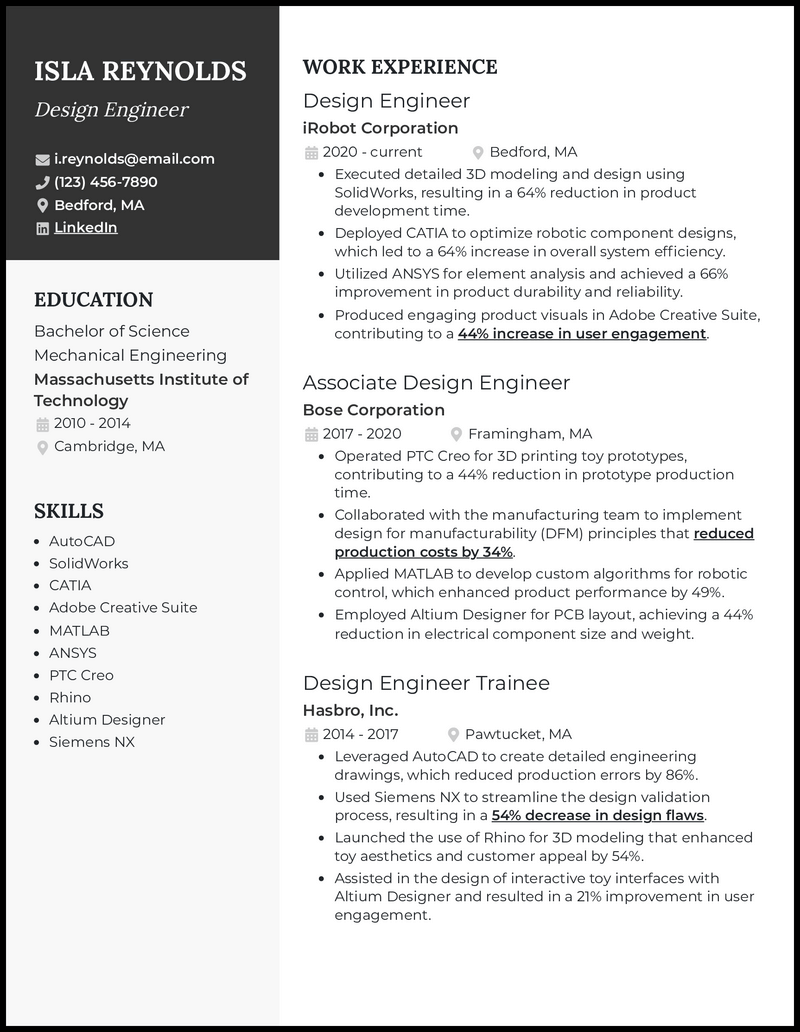As a design engineer, you’re the architect shaping innovation and functionality. Your creative flair and technical abilities bring ideas to life in a range of industries. With an eye for precision, you ensure every detail aligns seamlessly for an effective final result.
From designing cutting-edge products to optimizing existing ones, your skills extend from CAD mastery to material selection. It’s no wonder that creating a cover letter and crafting a resume that reflect all this can seem a little daunting.
No need to worry, though. We have all the expert tips and professional design engineer resume examples you need to get the job done—and then, literally, get the job.
Why this resume works
- By emphasizing your ability to deliver results in your design engineer resume you’ll grab the attention of potential employers. Highlight specific accomplishments that will portray you as an innovative and creative individual.
- For instance, have you been able to optimize robotic component designs? Have you enhanced customer appeal through your creativity and innovation? Great, capitalize on these, and the job is in your grasp.
Why this resume works
- What’s your track record in cutting operational costs and positioning companies for future growth? Well, it would help your product design engineer resume to get noticed if you included achievements such as saving 51% in licensing costs and a 57% increase in new feature ideas.
- Finally, showcase your modern technology competencies in streamlining processes, analyzing competition, and identifying helpful insights.
Why this resume works
- Are you looking for a winning approach to employ in your electrical design engineer resume? Look no further. Following Aurora’s footsteps will steer you toward achieving success. Put emphasis on quantifiable impacts to demonstrate your potential to deliver results and solve real-world challenges.
- Furthermore, showcase your proficiency in diverse software and tools- SKM PowerTools, MATLAB, etc. – effectively reducing design cycle times, improving project cost estimation accuracy, and enhancing project safety.
Related resume examples
Create a Design Engineer Resume That Gets You the Job

Your design engineer resume is the best place to showcase the skills that set you apart in the world of innovation. To make it as personal and tailored as possible, you need to get specific and steer clear of vague terms like “creative thinker.”
Since your expertise lies in design and engineering, dive into the technical nitty-gritty. Highlight your proficiency in CAD software, familiarity with various building materials, and your ability to bring concepts to life.
Mention specific design methodologies you’ve mastered and all the software you use to get tasks finished. As for soft skills, it’s best to showcase your knack for collaboration and effective communication in the work experience section.
Need some inspiration?
15 best design engineer skills
- AutoCAD
- SolidWorks
- Adobe Creative Suite
- SketchUp
- Rhino
- Material Selection
- PLM
- ANSYS
- Project Management
- Design Thinking
- Prototyping and Testing
- Altium Designer
- Revit MEP
- Python
- PTC Creo

Your design engineer work experience bullet points
In the dynamic world of design engineering, your resume’s work experience section is your canvas to showcase major accomplishments. Instead of dwelling on day-to-day tasks, shine a spotlight on your most significant contributions and impactful outcomes.
Whether it’s streamlining the product development lifecycle, optimizing designs for cost efficiency, or leading cross-functional teams to successful project completion, focus on what you’re good at and what the employer wants.
Next, you’ll want to quantify these achievements using metrics, such as reducing production costs by a percentage, enhancing design efficiency, and meeting tight project deadlines. You might not know the numbers off the top of your head, so do some research if you need to because this is the best way to show exactly how well you do your job.
- Quantify how your design optimizations led to a percentage reduction in production costs, demonstrating your commitment to resource efficiency.
- Specify how your project management skills accelerated time-to-market for product launches, providing metrics on shortened development cycles or faster prototyping processes.
- Demonstrate your commitment to precision by quantifying improvements in design efficiency.
- Highlight your ability to lead cross-functional teams by providing metrics on the number of successful and punctual project completions.
See what we mean?
- Conducted PSpice simulations, achieving a 66% increase in circuit efficiency and reliability
- Employed CATIA for 3D modeling, which saved 43% in design iteration times
- Spearheaded the integration of Rhino for organic shape modeling, leading to a 64% reduction in design time for complex, curved components
- Utilized MATLAB for complex algorithm development, which enhanced GPU performance by 78% through optimized power management
9 active verbs to start your design engineer work experience bullet points
- Innovated
- Optimized
- Collaborated
- Revitalized
- Engineered
- Implemented
- Executed
- Pioneered
- Championed
3 Tips for Writing a Design Engineer Resume as a Beginner
- Mention your coursework and technical skills
- Bolster your resume by listing coursework directly related to design engineering, showcasing your theoretical foundation. Include relevant technical skills and tools you’ve gained proficiency in, providing a snapshot of your capabilities that can help fill the gaps in your professional experience.
- Include hobbies and interests
- If your resume is looking a little bare, you can include relevant hobbies and interests that showcase your passion for design. This could include design competitions, contributing to open-source projects, or engaging in design-related communities.
- Internships count too
- If you’ve completed design-related internships or entry-level positions, highlight the practical experiences you gained. Discuss the specific projects you contributed to, the tools you utilized, and any positive outcomes or feedback you received.
3 Tips for Writing a Design Engineer Resume as a Seasoned Professional
- Highlight cross-functional collaboration
- Design engineering often involves working with diverse teams. Showcase your ability to collaborate by emphasizing successful cross-functional and cross-departmental projects. Detail how you’ve worked with others to determine the needs of varying teams and come up with effective solutions.
- Demonstrate design innovation
- Showcase your commitment to staying current by highlighting recent certifications, participation in industry conferences, or contributions to open-source design projects. Illustrate how you’ve applied new methodologies or tools, emphasizing your adaptability and forward-thinking approach to design challenges.
- Don’t forget metrics
- Quantify your design achievements with metrics that resonate. Reducing project timelines, increasing design accuracy, and achieving cost savings in production are all exciting metrics that give your resume that little bit of extra pizzazz. Providing this tangible evidence of your contributions really highlights why you should be the one who gets hired.
You don’t have to, but a targeted career summary can enhance your resume. Tailor it to the specific job, mentioning the company and role, and then use the space to emphasize design proficiencies, like CAD mastery or innovative project management.
Include certifications relevant to design engineering, such as AutoCAD, CSWP, PMP, or CPEM. Showcase how these certifications have enhanced your skills and contributed to successful project outcomes.
Look through the job description and make sure any design engineering software and skills mentioned are also on your list. It’s best to focus mainly on technical skills, while soft skills can be implicitly demonstrated in the work experience section.








